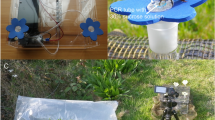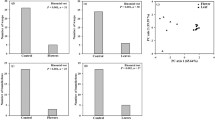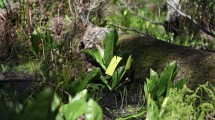Abstract
There is growing evidence of a substantial decline in pollinators within Europe and North America, most likely caused by multiple factors such as diseases, poor nutrition, habitat loss, insecticides, and environmental pollution. Diesel exhaust could be a contributing factor to this decline, since we found that diesel exhaust rapidly degrades floral volatiles, which honey bees require for flower recognition. In this study, we exposed eight of the most common floral volatiles to diesel exhaust in order to investigate whether it can affect volatile mediated plant-pollinator interaction. Exposure to diesel exhaust altered the blend of common flower volatiles significantly: myrcene was considerably reduced, β-ocimene became undetectable, and β-caryophyllene was transformed into its cis-isomer isocaryophyllene. Proboscis extension response (PER) assays showed that the alterations of the blend reduced the ability of honey bees to recognize it. The chemically reactive nitrogen oxides fraction of diesel exhaust gas was identified as capable of causing degradation of floral volatiles.




Similar content being viewed by others
References
Abrol DP (2012) Decline in pollinators. Pollination biology: biodiversity conservation and agricultural production. Springer, Netherlands, pp 545–601
Atkinson R, Arey J (2003) Gas-phase tropospheric chemistry of biogenic volatile organic compounds: a review. Atmospheric Environment 37(Supplement 2):197–219
Augusto O, Bonini MG, Amanso AM, Linares E, Santos CCX, DE Menezes SL (2002) Nitrogen dioxide and carbonate radical anion: two emerging radicals in biology. Free Radic Biol Med 32:841–859
Babushok VI, Linstrom PJ, Zenkevich IG (2011) Retention indices for frequently reported compounds of plant essential oils. J Phys Chem Ref Data 40:043101
Biesmeijer JC, Roberts SPM, Reemer M, Ohlemüller R, Edwards M, Peeters T, Schaffers AP, Potts SG, Kleukers R, Thomas CD, Settele J, Kunin WE (2006) Parallel declines in pollinators and insect-pollinated plants in Britain and The Netherlands. Science 313:351–354
Bitterman ME, Menzel R, Fietz A, Schafer S (1983) Classical conditioning of proboscis extension in honeybees (Apis mellifera). J Comp Psychol 97:107–119
Blight MM, Métayer ML, Pham-Delègue MH, Pickett JA, Marion-Poll F, Wadhams LJ (1997) Identification of floral volatiles involved in recognition of oilseed rape flowers, Brassica napus by honeybees, Apis mellifera. J Chem Ecol 23:1715–1727
Bommarco R, Marini L, Vaissière B (2012) Insect pollination enhances seed yield, quality, and market value in oilseed rape. Oecologia 169:1025–1032
Calogirou A, Larsen BR, Kotzias D (1999) Gas-phase terpene oxidation products: a review. Atmos Environ 33:1423–1439
Dobson HEM (1994) Floral volatiles in insect biology. In: Bernays EA (ed) Insect-plant interactions. CRC Press, London, pp. 47–81
Dobson HEM (2006) Relationship between floral fragrance composition and type of pollinator. In: Dudareva N, Pichersky E (eds) Biology of floral scent. CRC Press, Boca Raton, pp. 147–198
Dötterl S, Vereecken NJ (2010) The chemical ecology and evolution of bee-flower interactions: a review and perspectives. Can J Zool 88:668–697
Epstein D, Frazier JL, Purcell-Miramontes M, Hackett K, Rose R, Erickson T, Moriarty T, Steeger T (2013) USDA: report on the national stakeholders conference on honey bee health. http://www.usda.gov/documents/ReportHoneyBeeHealth.pdf. Accessed 27 August 2015
European Commission (2014) Environment: Commission takes action against UK for persistent air pollution problems. http://europa.eu/rapid/press-release_IP-14-154_en.htm
Fehsenfeld F, Calvert J, Fall R, Goldan P, Guenther AB, Hewitt CN, Lamb B, Liu S, Trainer M, Westberg H, Zimmerman P (1992) Emissions of volatile organic compounds from vegetation and the implications for atmospheric chemistry. Glob Biogeochem Cycles 6:389–430
Free JB (1993) Insect pollination of crops, 2nd edn. Academic Press, London
Fuentes J, Wang D, Bowling D, Potosnak M, Monson R, Goliff W, Stockwell W (2007) Biogenic hydrocarbon chemistry within and above a mixed deciduous forest. J Atmos Chem 56:165–185
Fuentes JD, Roulston TH, Zenker J (2013) Ozone impedes the ability of a herbivore to find its host. Environ Res Lett 8:014048
Ghazoul J (2005) Buzziness as usual? Questioning the global pollination crisis. Trends Ecol Evol 20:367–373
Girling RD, Lusebrink I, Farthing E, Newman TA, Poppy GM (2013) Diesel exhaust rapidly degrades floral odours used by honeybees. Sci Report 3:2779
Kerr JT, Pindar A, Galpern P, Packer L, Potts SG, Roberts SM, Rasmont P, Schweiger O, Colla SR, Richardson LL, Wagner DL, Gall LF, Sikes DS, Pantoja A (2015) Climate change impacts on bumblebees converge across continents. Science 349:177–180
Kjeldsen F, Christensen LP, Edelenbos M (2003) Changes in volatile compounds of carrots (daucus carota L.) during refrigerated and frozen storage. J Agric Food Chem 51:5400–5407
Klein A-M, Vaissière BE, Cane JH, Steffan-Dewenter I, Cunningham SA, Kremen C, Tscharntke T (2007) Importance of pollinators in changing landscapes for world crops. P Roy Soc Lond B Bio 274:303–313
Klun JA, Chapman OL, Mattes KC, Wojtkowski PW, Beroza M, Sonnet PE (1973) Insect sex pheromones: minor amount of opposite geometrical isomer critical to attraction. Science 181:661–663
Knudsen J, Eriksson R, Gershenzon J, Ståhl B (2006) Diversity and distribution of floral scent. Bot Rev 72:1–120
Kuwabara M (1957) Bildung des bedingten reflexes von pavlovs typus bei der honigbiene, Apis mellifica. Journal of the faculty of science, Hokkaido university, series 6. Zoology 13:458–464
Lee A, Goldstein AH, Keywood MD, Gao S, Varutbangkul V, Bahreini R, Mg NL, Flagan RC, Seinfeld JH (2006) Gas-phase products and secondary aerosol yields from the ozonolysis of ten different terpenes. J Geophys Res Atmos 111:D07302
McFrederick QS, Kathilankal JC, Fuentes JD (2008) Air pollution modifies floral scent trails. Atmos Environ 42:2336–2348
McFrederick QS, Fuentes JD, Roulston T, Kathilankal JC, Lerdau M (2009) Effects of air pollution on biogenic volatiles and ecological interactions. Oecologia 160:411–420
Naka H, Suzuki T, Watarai T, Horie Y, Mochizuki F, Mochizuki A, Tsuchida K, Arita Y, Ando T (2013) Identification of the sex pheromone secreted by synanthedon tenuis (Lepidoptera: sesiidae). Appl Entomol Zool 48:27–33
Oldroyd BP (2007) What’s killing American honey bees? PLoS Biol 5:e168
Pinto D, Blande J, Nykänen R, Dong W-X, Nerg A-M, Holopainen J (2007a) Ozone degrades common herbivore-induced plant volatiles: does this affect herbivore prey location by predators and parasitoids? J Chem Ecol 33:683–694
Pinto D, Nerg A-M, Holopainen J (2007b) The role of ozone-reactive compounds, terpenes, and green leaf volatiles (GLVs), in the orientation of Cotesia plutellae. J Chem Ecol 33:2218–2228
Pinto DM, Himanen SJ, Nissinen A, Nerg AM, Holopainen JK (2008) Host location behavior of Cotesia plutellae kurdjumov (hymenoptera: braconidae) in ambient and moderately elevated ozone in field conditions. Environ Pollut 156:227–231
Potts SG, Biesmeijer JC, Kremen C, Neumann P, Schweiger O, Kunin WE (2010) Global pollinator declines: trends, impacts and drivers. Trends Ecol Evol 25:345–353. doi:10.1016/j.tree.2010.01.007
Rachlin S (1971) Process for preparing isocaryophyllene. US Patent 3621070, 192.14, R448
Reinhard J, Sinclair M, Srinivasan MV, Claudianos C (2010) Honeybees learn odour mixtures via a selection of key odorants. PLoS One 5:e9110
Reissell A, Aschmann SM, Atkinson R, Arey J (2002) Products of the OH radical- and O3-initiated reactions of myrcene and ocimene. J Geophys Res 107:4138
Roderick WR (1966) Current ideas on the chemical basis of olfaction. J Chem Educ 43:510
Setiabudi A, Makkee M, Moulijn JA (2004) The role of NO2 and O2 in the accelerated combustion of soot in diesel exhaust gases. Appl Catal B Environ 50:185–194
Silverstein RM, Young JC (1976) Insects generally use multicomponent pheromones. In: Beroza M (ed) Pest management with insect sex attractants, ACS Symposium Series. American Chemical Society, Washington, pp. 1–29
Steffan-Dewenter I, Potts SG, Packer L (2005) Pollinator diversity and crop pollination services are at risk. Trends Ecol Evol 20:651–652
Titov AI (1963) The free radical mechanism of nitration. Tetrahedron 19:557–580
Vanbergen AJ, The Insect Pollinators Initiative (2013) Threats to an ecosystem service: pressures on pollinators. Front Ecol Environ 11:251–259
Wright GA, Schiestl FP (2009) The evolution of floral scent: the influence of olfactory learning by insect pollinators on the honest signalling of floral rewards. Funct Ecol 23:841–851
Acknowledgments
We acknowledge Wittko Francke for valuable comments on the manuscript, Christine M. Reitmayer for help with beekeeping. We also thank the Erbilgin lab at the University of Alberta for providing us with a trans-verbenol mass spectrum. Funding for this research has been provided through the Leverhulme Trust Research Project Grant RPG-089.
Author information
Authors and Affiliations
Corresponding author
Electronic supplementary material
ESM 1
(PDF 566 KB)
Rights and permissions
About this article
Cite this article
Lusebrink, I., Girling, R.D., Farthing, E. et al. The Effects of Diesel Exhaust Pollution on Floral Volatiles and the Consequences for Honey Bee Olfaction. J Chem Ecol 41, 904–912 (2015). https://doi.org/10.1007/s10886-015-0624-4
Received:
Revised:
Accepted:
Published:
Issue Date:
DOI: https://doi.org/10.1007/s10886-015-0624-4




